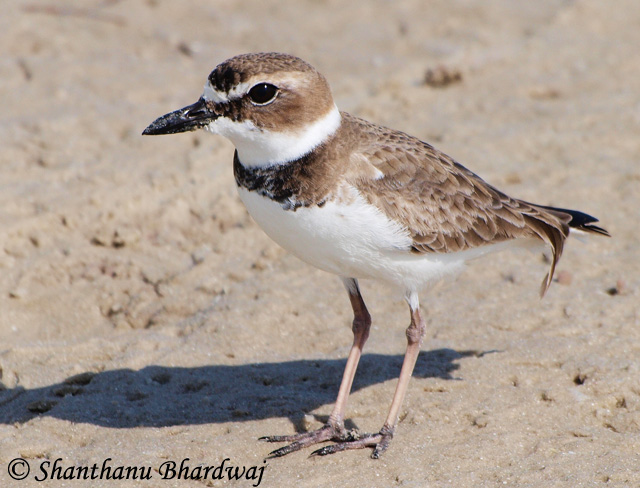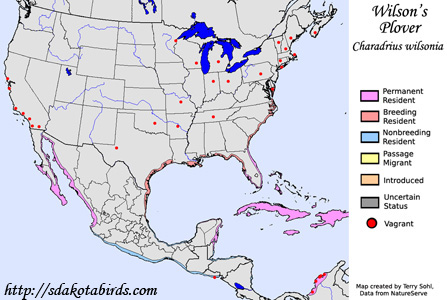| Length: 7.5 inches | Wingspan: 18 inches | Seasonality: Non-resident in South Dakota |
| ID Keys: White underparts, throat, and neck band, brownish upperparts, brownish head with white stripe on brow. Breeding birds have thick black band across chest, dark forehead. | ||
 The
Wilson's Plover is one of several similar plover species found in North
America, but they are distinguished from the
Semipalmated Plover, the
Piping Plover, and the
Snowy Plover by their relatively large
size, their large thick bill (they are sometimes referred to as the
"Thick-billed Plover"), and the complete thick dark band across their chest
when in breeding plumage. They also have a more southerly distribution
than the other similar plover species, as they are usually found only on the
Gulf coast and southern half of the Atlantic coast. Overall
populations are relatively small, but they are not listed nationally as
threatened or endangered. However, some individual states do list the
birds as protected.
The
Wilson's Plover is one of several similar plover species found in North
America, but they are distinguished from the
Semipalmated Plover, the
Piping Plover, and the
Snowy Plover by their relatively large
size, their large thick bill (they are sometimes referred to as the
"Thick-billed Plover"), and the complete thick dark band across their chest
when in breeding plumage. They also have a more southerly distribution
than the other similar plover species, as they are usually found only on the
Gulf coast and southern half of the Atlantic coast. Overall
populations are relatively small, but they are not listed nationally as
threatened or endangered. However, some individual states do list the
birds as protected.
Habitat: Found on coastlines with expanses of open beach or mudflats.
Diet: Feeds on many small marine creatures such as small crustaceans, mollusks, marine worms, and insects.
Behavior: Forages by running short distances along the shoreline, stopping briefly to look for food items, and then quickly making another short move.
Nesting: The Wilson's Plover builds a simple scrape nest on the beach, lined with small amounts of pebbles, shells, or beach debris. The female usually lays 3 eggs, and both parents help to incubate them. After the eggs hatch, both parents help tend to the young, but the hatchlings leave the nest almost immediately, and they feed themselves.
Song: The Wilson's Plover has a crisp, high-pitched kwit flight call. In flight display, they make a rattling series of notes.
Migration: Wilson's Plovers are generally not long-distance migrants, and they are considered permanent residents in much of their range. In the U.S. however, those on the central Atlantic coast, and many of those on the Gulf coast, move short distances southward for the winter.
Interactive eBird map: Click here to access an interactive eBird map of Wilson's Plover sightings
Similar Species: Most likely to be confused with the Semipalmated Plover. Also generally similar to the Piping Plover and Snowy Plover.
Conservation Status: Overall populations are not very large, and may be in decline in recent decades. However, the IUCN lists the Wilson's Plover as a species of "Least Concern".
Further Information: 1) USGS Patuxent Bird Identification InfoCenter - Wilson's Plover
2) Audubon Guide - Wilson's Plover
3) Field Guide to the Rare Animals of Florida - Wilson's Plover
Photo Information: Photo taken by Shanthanu Bhardwaj - December 23rd, 2009 - Marco Island, Florida - Photo licensed under Creative Commons Attribution ShareAlike 2.0 Generic License.
| Click below for a higher-resolution map |
 |
| South Dakota Status: Non-resident in South Dakota |
Additional Wilson's Plover Photos (coming soon!!)
